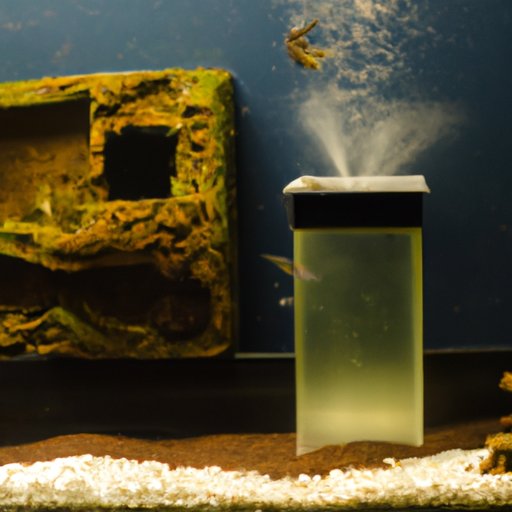Introduction
Having a fish tank at home can be a relaxing and rewarding hobby, but problems like cloudy water can quickly turn your aquatic oasis into a source of stress. Cloudiness is a common issue that can affect the health and happiness of your fish, as well as compromise the aesthetic appeal of your tank. In this article, we’ll explore the most common reasons why your fish tank is cloudy and what you can do to fix it.
Troubleshooting cloudy aquarium water
The first step in addressing cloudy water is identifying the cause. Cloudiness can result from a variety of factors, including overfeeding, poor filtration, and water chemistry imbalances. It’s important to be patient and persistent in troubleshooting, as multiple underlying issues may be contributing to the cloudiness. You may need to invest in tools and materials such as a water testing kit or a more powerful filter to resolve the issue.
5 reasons why your fish tank is cloudy and how to fix it
Here are the most common reasons why your fish tank may be cloudy, along with step-by-step instructions for solving each problem:
-
Overfeeding
Excess food in the tank can contribute to cloudy water by encouraging the growth of bacteria and algae. To fix this issue, reduce the amount of food you feed your fish and remove any uneaten food from the tank after a few minutes. You may also want to adjust your feeding schedule to prevent leftover food from accumulating in the water.
-
Insufficient filtration
Your filter may not be powerful enough to handle the amount of waste and debris in the tank, leading to cloudy water. Check your filter manufacturer’s recommendations for the appropriate filter size for your tank. You may also need to clean or replace your filter to improve its effectiveness.
-
Water chemistry imbalances
Cloudiness can also result from imbalances in the chemical composition of your tank’s water, such as excessive nitrate or phosphate levels. Test your water regularly using a water testing kit and adjust the chemical levels as necessary. You may also want to consider adding live plants to your tank, which can help regulate the water chemistry.
-
New tank syndrome
If you’ve recently set up your tank, it may be experiencing “new tank syndrome,” which is characterized by cloudy water caused by an accumulation of beneficial bacteria. This issue typically resolves itself within a few weeks, but you can speed up the process by adding beneficial bacteria supplements to the tank and reducing the amount of food you feed your fish.
-
Abrupt changes in water temperature or quality
Rapid temperature changes or adding tap water that hasn’t been treated properly can contribute to cloudiness. Be sure to gradually adjust the temperature of the water and treat tap water with a water conditioner before adding it to the tank.
The ultimate checklist to clearing up cloudy fish tank water
To clear up cloudy water effectively, follow these steps:
- Test your water to identify any chemical imbalances or other issues
- Reduce the amount of food you feed your fish
- Clean or replace your filter as necessary
- Add beneficial bacteria supplements or live plants to regulate the tank’s ecosystem
- Gradually adjust the temperature of the water to prevent shocking the fish
- Treat tap water with a conditioner before adding it to the tank
It’s important to note that some issues, such as new tank syndrome or bacterial blooms, may require patience and time to resolve completely.
The facts about cloudy aquarium water: how to identify, prevent, and treat
While cloudy water can be frustrating, it’s important to understand the biological processes that lead to the issue in order to prevent it from occurring in the future. Cloudy water can be caused by a variety of factors, including bacterial blooms, fungi, and algae. Ongoing maintenance, such as regular water changes, cleaning, and testing, can help prevent these issues from developing. Adding live plants or other natural components to the tank can also help maintain a healthy and balanced ecosystem.
Top 10 best practices for maintaining clear and healthy fish tank water
Here are the top recommendations for maintaining a healthy and clear fish tank:
- Test your water regularly and adjust chemical levels as necessary
- Feed your fish the appropriate amount of food and remove any excess or uneaten food
- Clean your tank and equipment on a regular basis to prevent the accumulation of waste and debris
- Invest in a powerful and appropriate-sized filter for your tank
- Add live plants to your tank to help regulate the ecosystem and absorb excess nutrients
- Gradually adjust the temperature of the water to prevent shocking the fish
- Use a water conditioner to treat tap water before adding it to the tank
- Avoid sudden changes in the tank’s environment, including water flow and lighting
- Quarantine any new fish before introducing them to your main tank
- Observe your fish regularly and monitor their health and behavior
Conclusion
Cloudy water is a common issue that can affect the health and happiness of your fish, but by following these guidelines and troubleshooting strategies, you can get your tank back to its crystal clear state in no time. Most importantly, don’t forget to enjoy the process of taking care of your fish and their habitat, and share your tips and experiences with your fellow aquarium enthusiasts.
